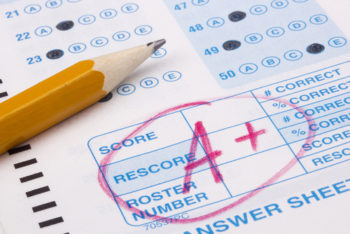Skim reading your A&P syllabus is a big mistake!
Have you asked: ‘What syllabus for anatomy and physiology?’ Did you skim read your syllabus for A&P and put it at the bottom of that pile of papers your received on the first day of class?
You know…that 10 or more pages of typewritten information with instructions, test dates, list of reading material, and rules and regulations of the Biology Department. It is so easy to skim read it for exam dates and decide that the rest of it will become clear in class. It is a very long and boring document, but you really need to read it in detail anyway.
What is an A&P syllabus?
What does an A&P syllabus do? Listen carefully to the words your instructor uses to explain what is in the anatomy and physiology syllabus. This a very important document to you. You need this information.
Write your instructor’s exact words down as soon as you can. Verbal mistaken communication is much more common than precise communication. And, because your syllabus often reads like a legal document, it is easy to miss important items.
The next day read what you wrote. Does it make sense? If not, go to your instructor’s office hours and get clarification. This document is like a contract between you, your instructor, and your educational institution.
Do not take your class syllabus lightly. Your instructor probably had some input about the wording, but this is a document dictated by your academic department.
Academic department administrators love the syllabus because, for them, it is a contract that helps them sort out complaints as they arise.
The syllabus/contract sets expectations for both the students and the faculty. Your instructor may or may not have had input to how your syllabus is written. But your instructor will know the document in great detail.
Reasons why A&P begins with a syllabus
Exam dates
There are many reasons why A&P courses begin with a syllabus on the first day of class. First, your anatomy and physiology syllabus lists exam dates and required reading assignments.
Most institutions give students a short time to drop a class without a grade. Often this drop date is before the first exam. Study your syllabus as soon as you get it to decide whether to stay in or drop out of the course before you are stuck in a no-win situation.
Your syllabus will have a list of reading assignments and the required study time commitment. If you are taking a heavy load of other classes this semester, it may be best to put off your class in anatomy and physiology until next semester. Calculate your available hours of study for A&P.
Exam formats
Check whether there is anything in your syllabus about the format of quiz and exam questions. Will the questions be multiple choice, fill-in-the-blank, matching ideas, short answer sentence, essay, or some predictable combination of all these?
How many types of exams will there be? How is each exam weighted toward your grade? If answers to these questions are not in your syllabus, ask your instructor.
Will you be filling in a Scranton answer sheet? It is very easy to get the right answer into the wrong box on Scantron answer sheets. Be careful at test time.
Instructors are happy to provide this type of information in advance when it is not spelled out clearly on the syllabus. But they become annoyed if you complain about something later that is clearly outlined in the syllabus.
Time conflicts
Make sure you are clear about test dates and required time in class to avoid time conflicts. Get out your calendar. Do you have any conflicts with your other classes on those dates? What happens if you miss a lecture or laboratory session? Does your syllabus address these situations? Is there a protocol described for arranging testing at other than the scheduled time? What happens if you become ill or weather cancels classes?
Search your syllabus for the course rules. Do this during the first week of class. Everything will go smoother if you do this early rather than late in the course.
Atmosphere of the course
The Couse atmosphere may be very serious or very easy going. The tone of the syllabus will tell you which to expect.
Ask your instructor to clarify all items in the syllabus that you find the least bit unclear. Your anatomy and physiology instructor will be pleased to answer all your questions, because it will be proof that you read the syllabus that took so much time to write in the first place.
Do not underestimate the importance of your class syllabus/contract. Read it often! Do not stick it at the bottom of your backpack and forget it.
Further reading
Space Anatomy and Physiology Study
Do you have questions?
Please put your questions in the comment box or send them to me by email at DrReece@MedicalScienceNavigator.com. I read and reply to all comments and email.
If you find this article helpful share it with your fellow students or send it to your favorite social media site by clicking on your favorite social media button.
Margaret Thompson Reece PhD, physiologist, former Senior Scientist and Laboratory Director at academic medical centers in California, New York and Massachusetts is now Manager at Reece Biomedical Consulting LLC.
She taught physiology for over 30 years to undergraduate and graduate students, at two- and four-year colleges, in the classroom and in the research laboratory. Her books “Physiology: Custom-Designed Chemistry”, “Inside the Closed World of the Brain”, and her online course “30-Day Challenge: Craft Your Plan for Learning Physiology”, and “Busy Student’s Anatomy & Physiology Study Journal” are created for those planning a career in healthcare. More about her books is available at https://www.amazon.com/author/margaretreece. You may contact Dr. Reece at DrReece@MedicalScienceNavigator.com, or on LinkedIn.
Dr. Reece offers a free 30 minute “how-to-get-started” phone conference to students struggling with human anatomy and physiology. Schedule an appointment by email at DrReece@MedicalScienceNavigator.com.




